Simple ingredients, individual flavors and healthy meals is the basis for traditional foods in Crete. Here is a list of all the best food, wine and drink for you to try in Crete or any Greek restaurant.
The diet of Crete forms much of the basis of the now famous Mediterranean diet known for its health benefits including reduced cardiovascular disease and cancer rates. Within Greece, Crete’s cuisine stands out for its flavors and traditional dishes.
Wine and bread usually accompany lunch and dinner. Sweets and a drink of raki, a digestive, commonly end a meal. Many consider wine and olive oil the “holy alliance” in the Cretan diet, and often if you find olive trees, a vineyard is nearby. Families produce their own olive oil and wine, a tradition that continues even today.
This guide of traditional foods in Crete cuisine shares what we discovered in our travels and will be taking back to our kitchen at home.
Traditional Foods in Crete to Try
Eating in Crete is a pleasure. With the focus on a small number of key ingredients, it is easy to sample many of the best, traditional foods in Crete.
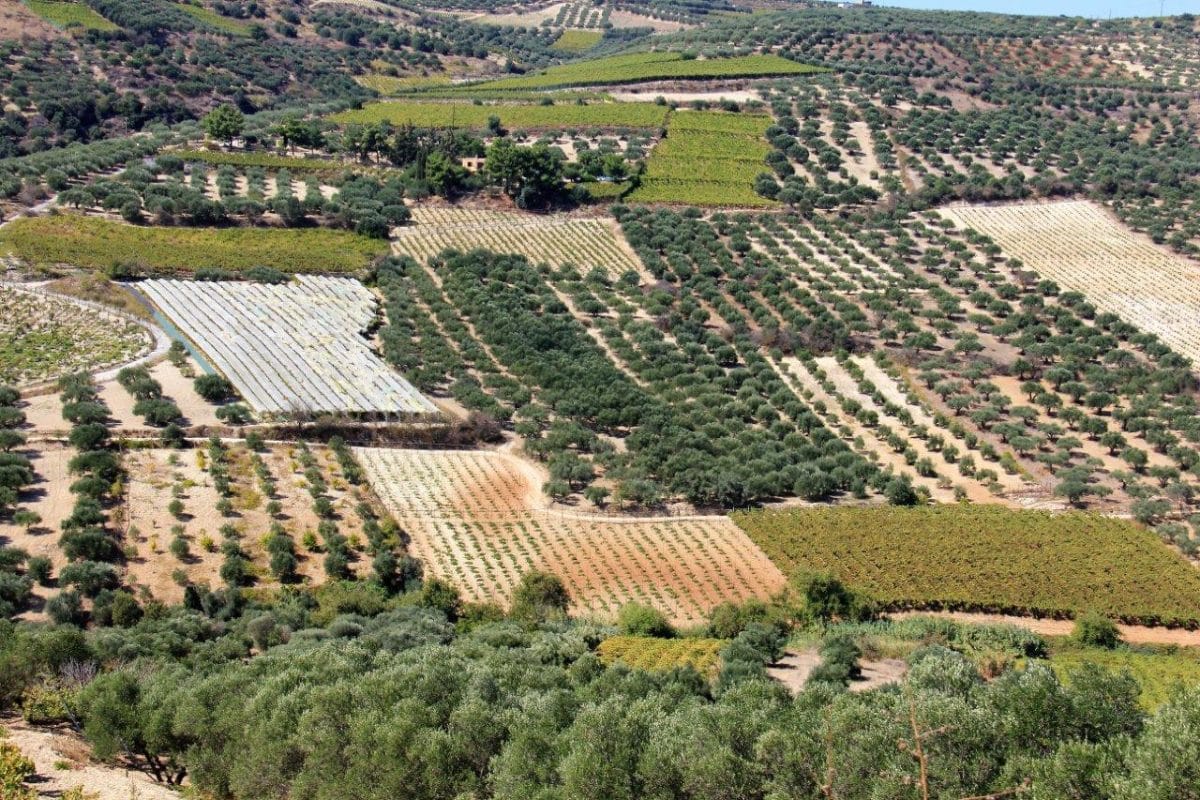
Olive Oil on Crete
With olive tree cultivation on Crete for over 4000 years, and over 30,000,000 olive trees, Crete knows a bit about producing top quality olive oil! The oldest olive trees on Crete are over 2,000 years old!
Olive trees bloom in the Spring and the harvest begins in the autumn, usually the beginning of November, and lasts 2-3 months, but it varies based on weather and location. In a warm year, mid-October for harvest is not uncommon.
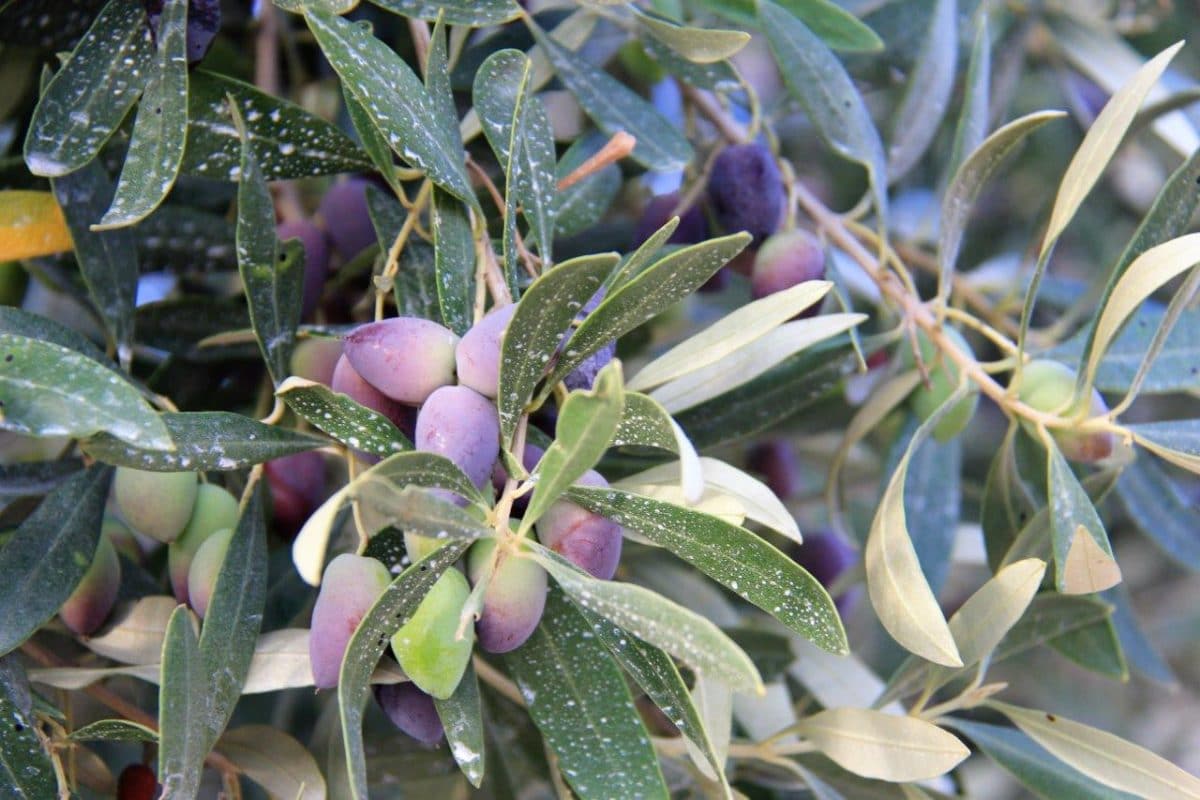
90% of the olive oil produced in Crete is extra virgin olive oil (EVOO) processed without chemical interventions. Low acidity, less than .05, rich aroma and particular flavors are characteristics of olive oil from Crete. High in antioxidants, olive oil is a healthy oil or fat. You can learn more about Greek olive oil here.
People who follow a traditional Cretan diet, also widely known as the Mediterranean diet, have low rates of cardiovascular disease and cancer – living longer and generally healthier than others. One of the secrets seems to be eating healthy fats. In Crete, the primary source of healthy fats is olive oil. The average olive oil consumption in Crete per person annually is 35 liters! So, for a household of 4 – that is 140 liters of olive oil – almost 3 liters a week. Many people drink a shot of olive oil daily.
Backed by multiple scientific studies, the health benefits of the Mediterranean diet include lower rates of cancer and diabetes, and better heart health (including lower cholesterol).
And as a tourist, you notice how much olive oil you consume – salads, breads, meats, everything served with a generous amount of olive oil, the “Gold of Crete.”
Where to Learn more about Olive Oil in Crete?
Visit an olive oil production facility. There are many on the island offering tours. We visited Anoskeli, which produces olive oil and wines just outside of Chania. (The “holy alliance” mentioned above.)
The tasting includes both olive oil and wine. Anoskeli serves the olive oil with bread, lemon, salt and oregano, a traditional way to serve it in Crete. I have to say this was delicious and I am adopting this for serving bread in my home! Lemon, salt, oregano and olive oil together represent the great flavors of Crete. So simple, but using good, fresh ingredients makes all the difference. Feta cheese and/or tomatoes with this combination is also common and delicious.
Up next, a tasting of five Anoskeli wines and raki. A snack served with the wine tasting is 5 euros per person. Commonly found in restaurants, Anoskeli, grow six different wine varieties in their own vineyards including white, red and rose wines sold under the AnoPLAYA and Anoferia Wine labels. Ano Kato is the label for their raki (tsikoudia). See more on raki and Crete wines below.
The tasting also includes a tour of the modern, state of the art olive oil production facilities. Learn how olive oil is produced and standardized in commercial production.
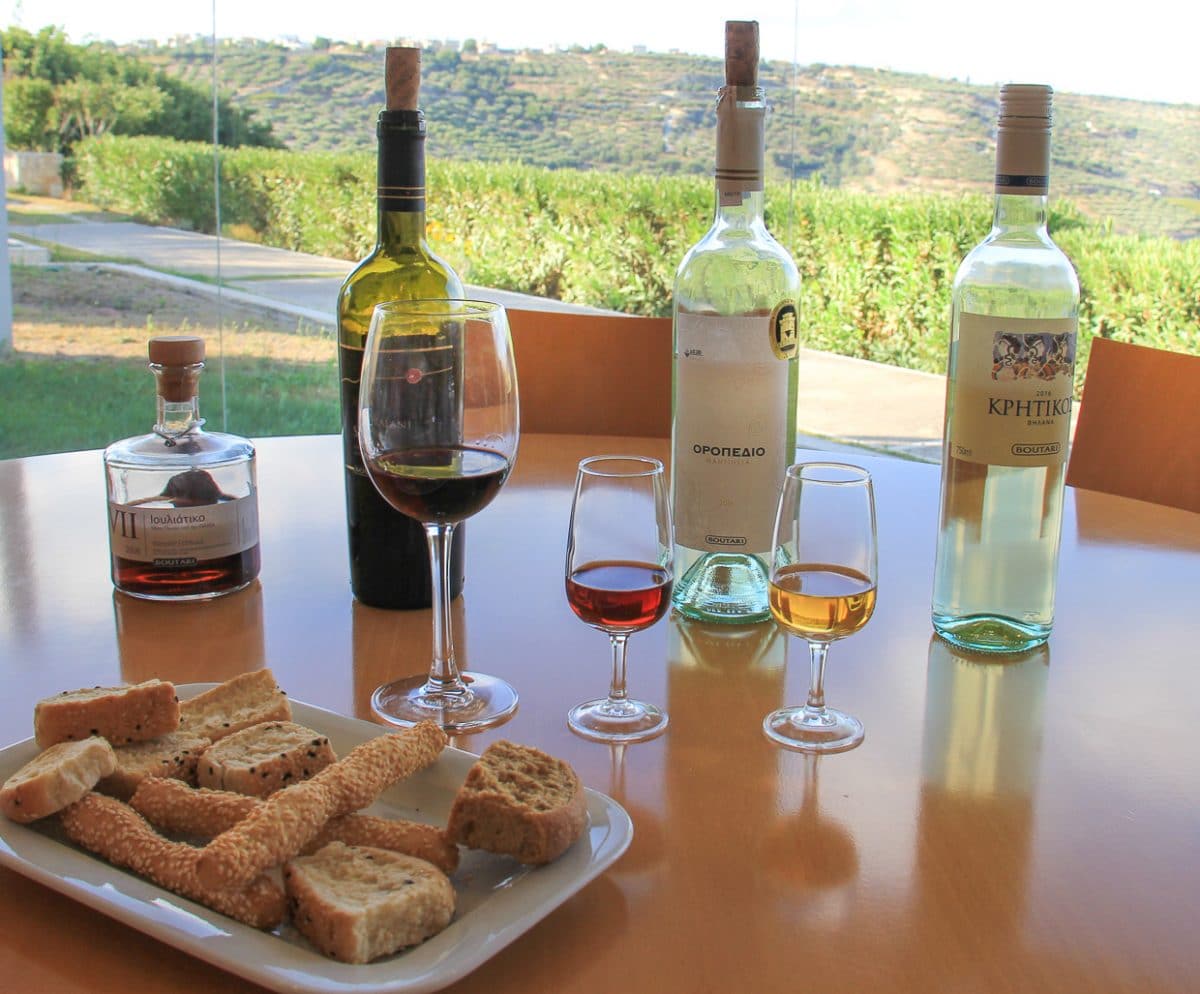
Wines of Crete
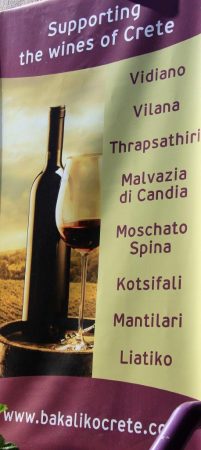 Well, it’s not quite a traditional food in Crete, but we are going to cover wine as well.
Well, it’s not quite a traditional food in Crete, but we are going to cover wine as well.
With 6,000 years of wine making behind it, learning about Cretan wines serves as a history lesson as well. The oldest existing wine-press dates back 3,500 years. It was found in Vathipetro, near Archanes, a popular wine region of Crete. Minoan ruins have underground wine storage facilities and the Minoan traded wine and other products from Crete.
Amphora, the earthen ware jugs used for wine making and storage have also been widely found. (Raki also uses similar jugs for storage.) In order to supply the Roman empire with wine, widespread cultivation of vines occurred in Crete. Later under Venetian rule, exporting of wine resumed. In 1415, records indicate over 20,000 barrels of wine exported from Crete. One hundred and fifty years later, this increased to 60,000 barrels.
The most common varietals of wine in Crete are vilana and vidiano (white) and Kotsifali (red). Syrah and Kostifali are a common blend. Liatiko, used to make a sweet desert wine served chilled, grows as well. A glass of liatiko welcomed us at Scalani Boutari Winery & Residences.
To learn more about Crete wines, we suggest you visit:
- Bakaliko, in the village of Archanes offers a variety of wine flights to try wines from both Crete and greater Greece.
- Archanes is in the center of one of Crete’s largest wine producing regions and provides easy access to a number of wineries including Lyrarakis Wines, Boutari Scalani Hills Winery, and Minos Wines.
- Boutari Scalani Hills Winery and Residences provides accommodation, including a tour and tasting, at a local winery. The Boutari family is one of the oldest and largest wine producers in Greece, not just Crete. The video shown on the tour of the winery about Wines of Crete is excellent for understanding both historical and current day wine production in Crete.
- Visit Anoskeli Winery (see above) and learn about olive oil production as well.
Raki
We’re not just covering traditional foods in Crete, but traditional drinks as well.
Tsikoudia, also known as raki, is considered the Cretan Spirit (although common throughout all of Greece.) Distilled from the must, the skins and stems left over after making wine, much like grappa, the season for making raki follows the wine harvest. Considered a brandy, raki contains about 40% alcohol. A fairly strong drink, raki quite often comes complimentary with a small desert at a restaurant when requesting the check. Raki, is generally served chilled, as it is considered a digestive.
Locals also drink raki served with small snacks or mezes as an aperitif.
Several times we had it flavored with honey. It tastes much better with honey! At Gargadoros Taverna in Agios Nikolaos, the raki was flavored with honey and pomegranate using his mother’s secret recipe. The best raki of the trip (and we tried a lot of raki!)
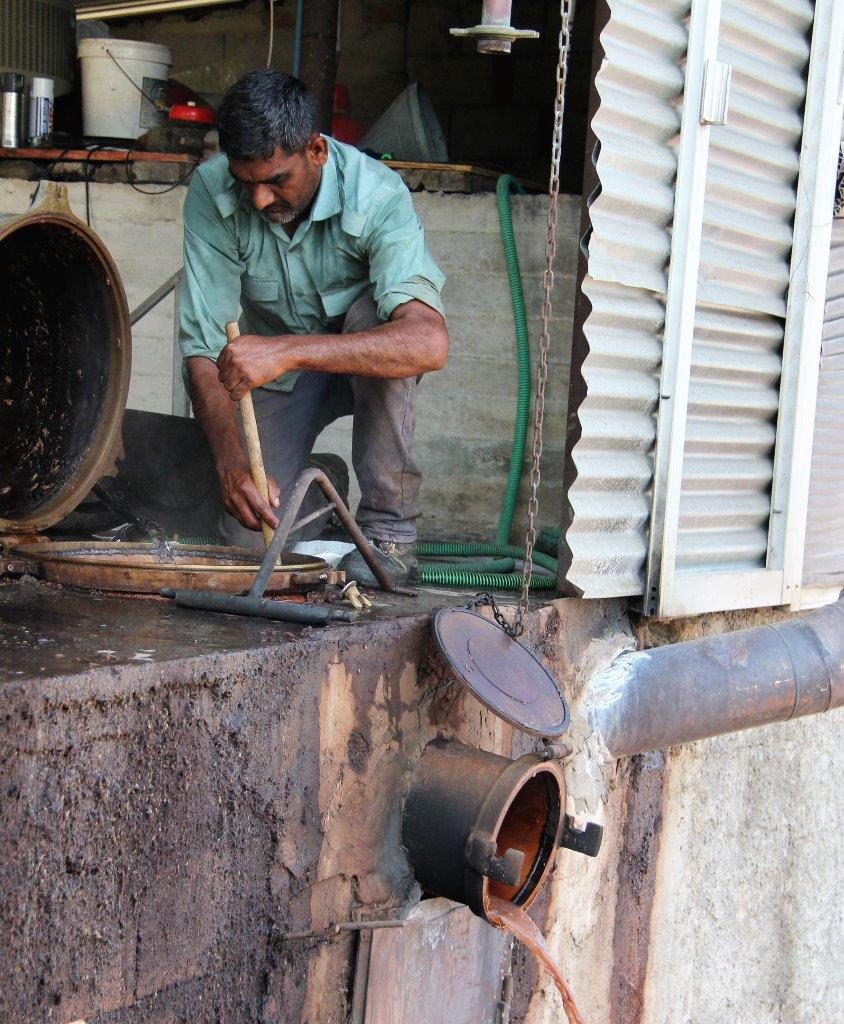
The season for making raki follows wine making, usually mid-October to early November in Crete. Tsikoudia, is a protected designation of the EU and considered original when it comes from Crete. Some commercial production exists, but most of the production is by local folks for their own consumption or serving at their restaurant. Much like the “village” wine concept, so widespread throughout Greece.
When we found our visit coincided with raki season we of course wanted to observe making raki first-hand. But there is not much tourism, i.e. no raki making trip offered on Crete. Maybe there is an opportunity there for some enterprising soul. However, we were in luck, receiving an invitation from Vasilis, the chef at the Kapsaliana Village Hotel to accompany him and a couple of other guests to observe raki being made and visit to a local cheesemaker.
Making “Village” Raki the Traditional Way on Crete
Stems and seeds are kept for about 40 days in barrels, during which time fermentation takes place. A distillery, traditionally called a rakokazano or raki boiler, comprises sealed copper boiler(s) containing the stems and seeds, some remnant wine and water, and a series of long, copper funnels and tubes. Once the “bonfires” are lit under the copper boiler and the temperatures inside the boiler reach the requisite level, distilled liquid is collected in glass containers.
A traditional rakokazano is a one man show. And, distillers are called kazanari. Nothing goes to waste in Crete. Even the fuel for the “bonfires” is recycled product in the form of crushed olive stones! No aging of the spirit occurs here, we were tasting spirit still warmed by the distillation process.
This does not take place in a commercial facility, there is no occupational health and safety in sight. Where we went to see raki being made was a traditional process. This explains the lack of tourism around it.
You can read more about the history of raki production on Crete here. And here is a short video showing the kazanari preparing the raki boiler:
Cheesemaking on Crete
If you are seeking to try the best, traditional foods in Crete, you must try the traditional cheeses. Enjoying traditional, Cretan cheeses is one of the culinary highlights of any visit to Crete. Almost all restaurants in Crete offer cheese platters, featuring a wide variety of locally-produced cheeses. You will often see it as an appetizer, as its job is to cleanse the palate and stimulate the appetite. Try it with raki, or maybe a local wine.
Sheep’s milk cheeses dominate in Crete. Goat’s milk cheeses are also popular and there is also some cow’s milk cheeses. If you’ve never tried sheep or goat’s milk cheese, then here is your opportunity. And, they are healthier cheeses then cow’s milk cheeses!
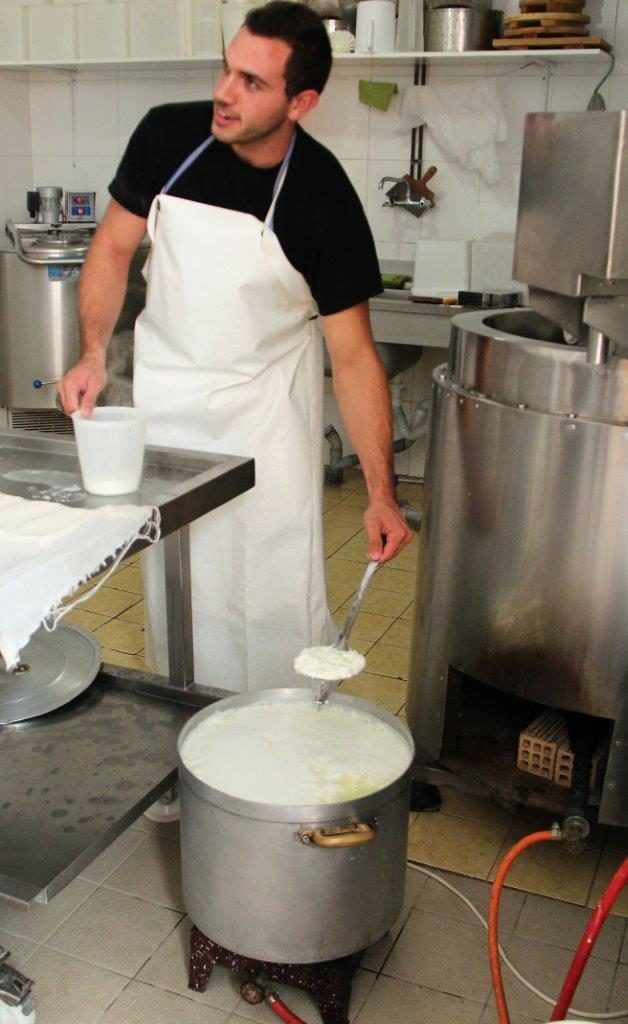
Some of the more popular cheeses to look out for are:
Kefalograviera is usually made from sheep’s milk but may also contain both sheep and goat’s milk. It’s a hard table cheese and is often the cheese of choice for saganaki.
Kefalotyri is a semi-hard, salty cheese which is traditionally aged in mountain huts. It’s also quite common on Cyprus. It tastes a little like gruyere and is considered the ancestor cheese for all Greek, hard cheese varieties. A lovely cheese to enjoy with grapes, figs and pears, or maybe on your pizza, accompanied with some red wine, of course. It is widely available outside Greece.
Myzithra is an unpasteurized cheese made with the whey of sheep’s cheese, although goat’s or cow’s milk is not uncommon either. You can buy it dried, but the more popular variety is the fresh cheese, which you need to consume within a couple of day. Myzithra is just glorious served with nuts and honey to enjoy at either breakfast or as a dessert!
Watch it being made right here at Zamaroc in this short, 25 second video. It’s guaranteed to make you hungry:
In contrast to the raki making, Zamaroc’s cheesemaking facility is a modern, clean facility. Kapsaliana Village Hotel and many other restaurants and hotels serve these handmade cheeses. The father of Themis Markoulokis, the cheesemaker, raises sheep so becoming a cheesemaker keeps him close to the family business.
A cool room at the factory, provides an aging room for many of the local hotels and restaurants to age their cheeses. Traditionally cheese would age in mountain huts or just be eaten fresh.
It’s not just the cheeses that are brilliant on Crete but the yogurt as well! Try some at breakfast with honey and walnuts.
And by the way, you can buy cheese and yogurt, all at incredibly reasonable prices, from Zamaroc.
Honey
Cretans love honey! One of Hippocrates foods for holistic health, honey provides many health benefits.
Honey and yogurt make a simple dessert or breakfast. Raki pancakes and loukoumades are also served with honey.
Thyme honey was the most common flavor we found, but there are many. Visit Melomania Honey, a shop in Chania, to learn all about the health properties of honey and the varieties found on Crete.
Depending on the source of pollen for the bees, the health benefits of honey vary. Thyme honey, from Chania, improves the function of the respiratory system, while orange tree honey improves the circulatory system. Other varieties boost the immune system, strengthen the nervous system, provide allergy relief and many other benefits. Visit the shop to learn more about the health benefits of honey.
To Sample Traditional Food in Crete Try These Dishes
Here are some specific dishes which incorporate many of the ingredients we have already written about, look for these on local menus.
Strapatsada, Greek Scrambled Eggs
Tomatoes gently cooked in a liberal amount of olive oil, with whisked eggs and feta added towards the end. You’ve never tasted scrambled eggs like these! A very popular breakfast meal in Crete, you can make strapatsada yourself in your kitchen and still get to try traditional foods in Crete without leaving home. We had these several times for breakfast on our trip including at Split Mas in Athens.
Dakos and Rusks
Of all the traditional foods in Crete, dakos seems the most common. Dakos are Cretan barley rusks, soaked in Olive oil, then topped with chopped tomato and fresh whey cheese. Served at any meal and found in almost any restaurant on Crete.
Cretan rusks are hard, twice cooked bread originally developed as a more nutritious form of bread which would last longer and travel well for field workers. Traditionally made from wheat and/or barley flour, there is also a version made from chickpea flour.
Extremely popular, rusks are served in every bread basket at every meal in Crete providing plenty of opportunities to try them.
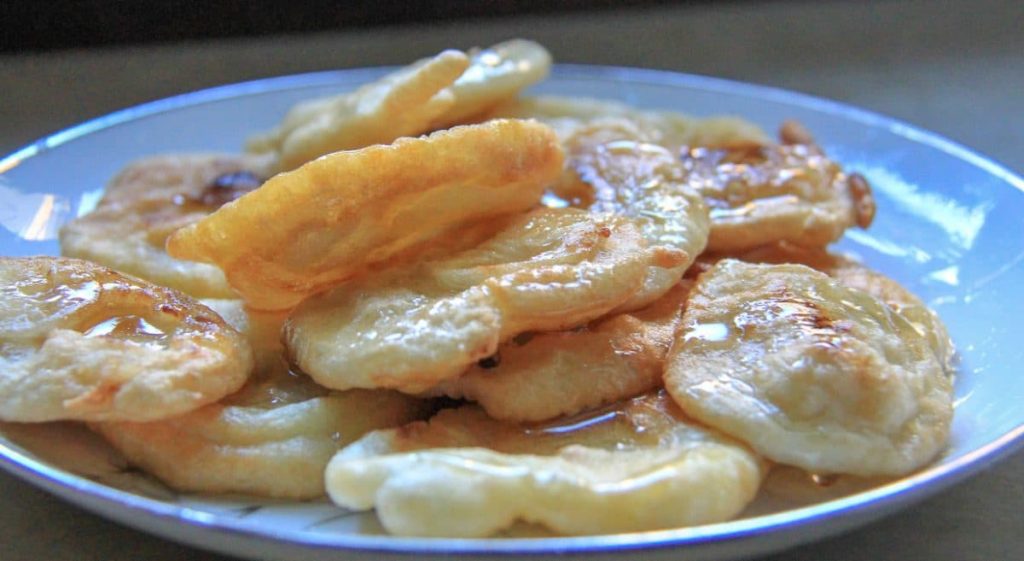
Raki Pancakes
We enjoyed these small, gourmet raki pancakes for breakfast at the Kalimera Archanes Village and at Kapsaliana Village Hotel.
Yes, raki for breakfast! These small pancakes, served with honey, contain a small dash of raki. They are a delightful way to start the day.
Slow Cooked Lamb
One of our favorite, main-course options for sampling traditional foods in Crete is to enjoy slow cooked lamb. We enjoyed this classic method of cooking lamb at Kapsaliana Village, near Rethymnon and for dinner at Scalani Boutari Hills Winery. But, we also spied it on many Cretan menus in our travels. Sheep on Crete are lean, organic and full of flavor from the plants and herbs they forage on. You can make slow cooked leg of lamb yourself at home. It’s easy.
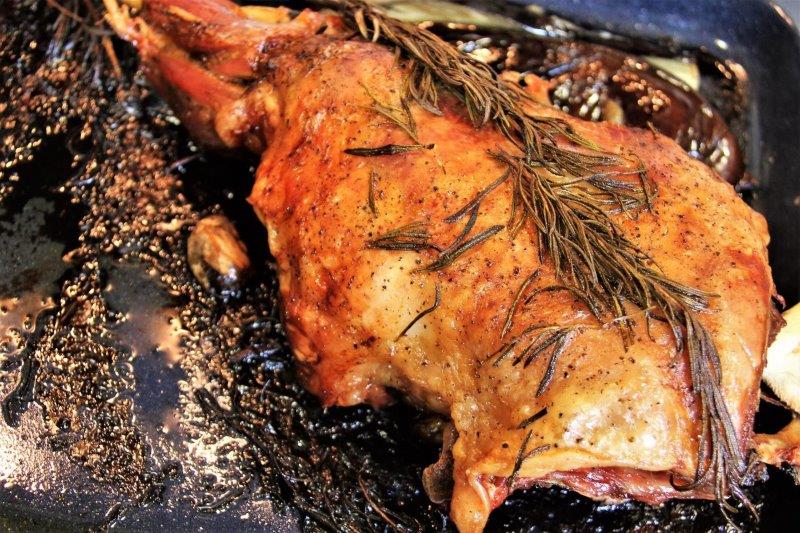
Cretan-Style Chicken
There are three ingredients in Crete, you will see over and over, being lemon, olive oil (always in liberal quantities) and oregano. Oregano, along with a variety of other herbs, just grows wild on Crete. A dish which takes full advantage of this is lemon grilled chicken. Look out for it on menus. You can easily make your own version of Greek lemon chicken and learn all about oregano and other wild herbs here, coming soon on Compass & Fork.
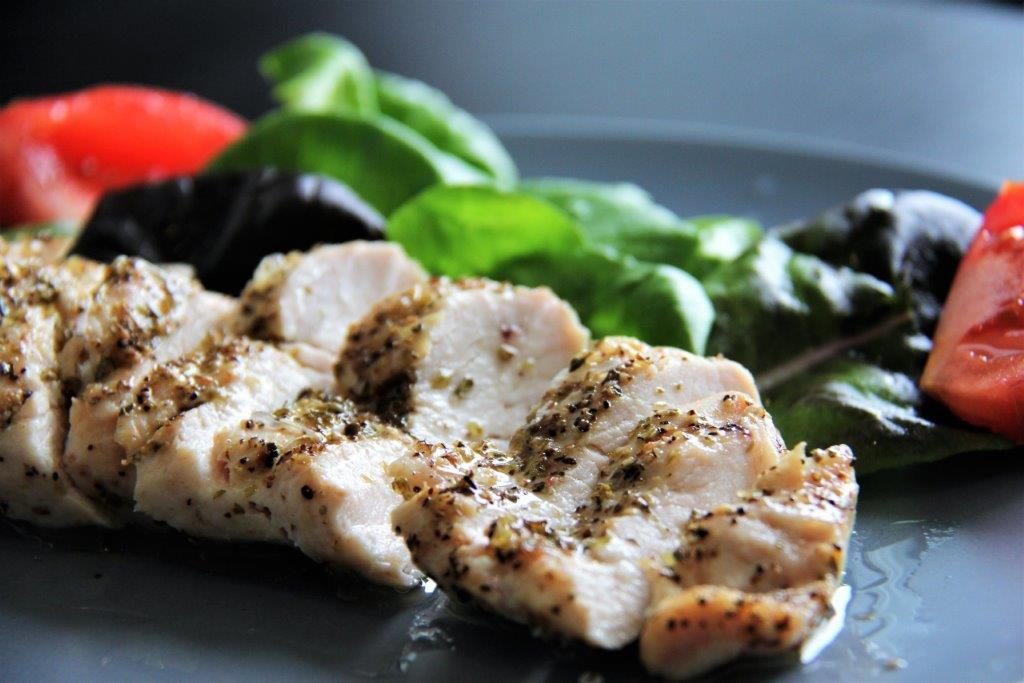
Horta or Wild Greens
One of the first traditional foods in Crete you encounter on a menu is horta, or wild greens. They seem to be everywhere with over 300 edible “weeds” in Crete including black mustard, kale, chicory, nettle, fennel, wild sorrel, and samphire. The most popular “wild green” on a menu stamnagathi, or spiny chicory, is lightly steamed and served with olive oil and lemon juice.
Wild greens vary by restaurant and seasonal availability, serving what grows locally. Many of these “wild” greens we pay a premium for at home! If you aren’t getting enough green vegetables in Crete, which we find an issue some places we travel, you aren’t trying hard enough!
In Syros, we discovered, fennel pie, a local specialty, we also found at a couple of restaurants focusing on traditional foods in Crete. Made with the greens from the fennel bulb, if you have the opportunity, try it.
As horta is generally found on most menus, just look for it.
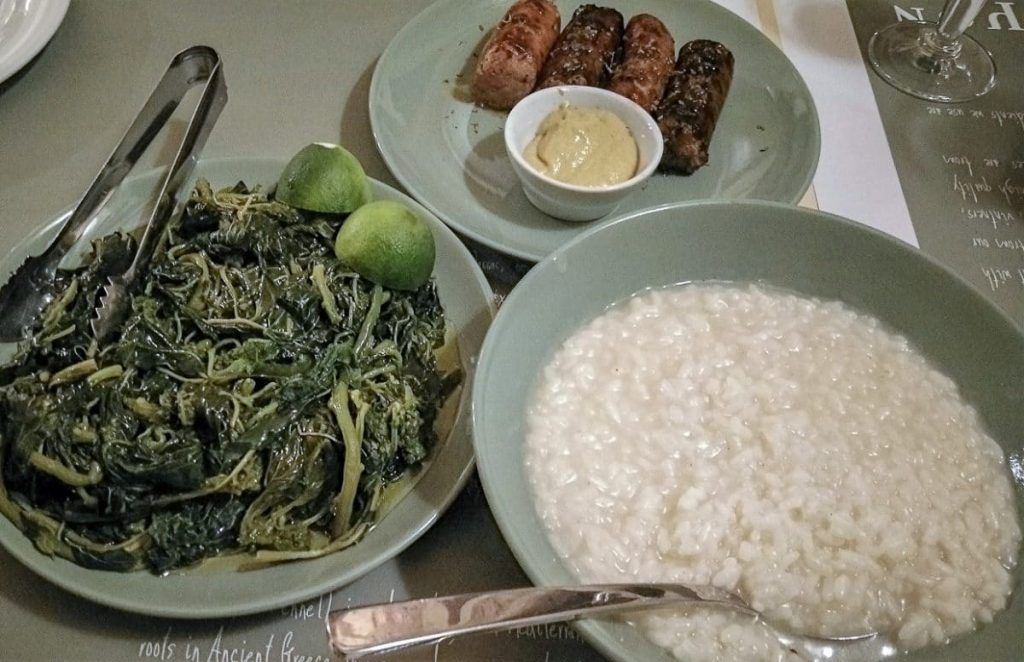
Wedding Rice
Gamopílafo, or wedding rice, traditionally served at, you guessed it, weddings. A simple dish of rice cooked in stock or broth usually of lamb, with butter and lemon. We enjoyed this at Kritamon, just off the village square in Archanes, and it’s amazing how something so simple has so much flavor. Imagine a plain risotto, the best you’ve ever tasted, and you’ll come close to Kritamon’s wedding rice. The secret is in the lamb stock.
Apáki
Pork marinated for several days in wine vinegar, then wrapped and smoked with aromatic herbs, this dish is usually served warm to bring out its flavors. Often used to flavor other dishes, greens or beans or as a meat on pizza or in pasta.
We also tried apaki at Kritamon in Archanes village and it was magnificent!
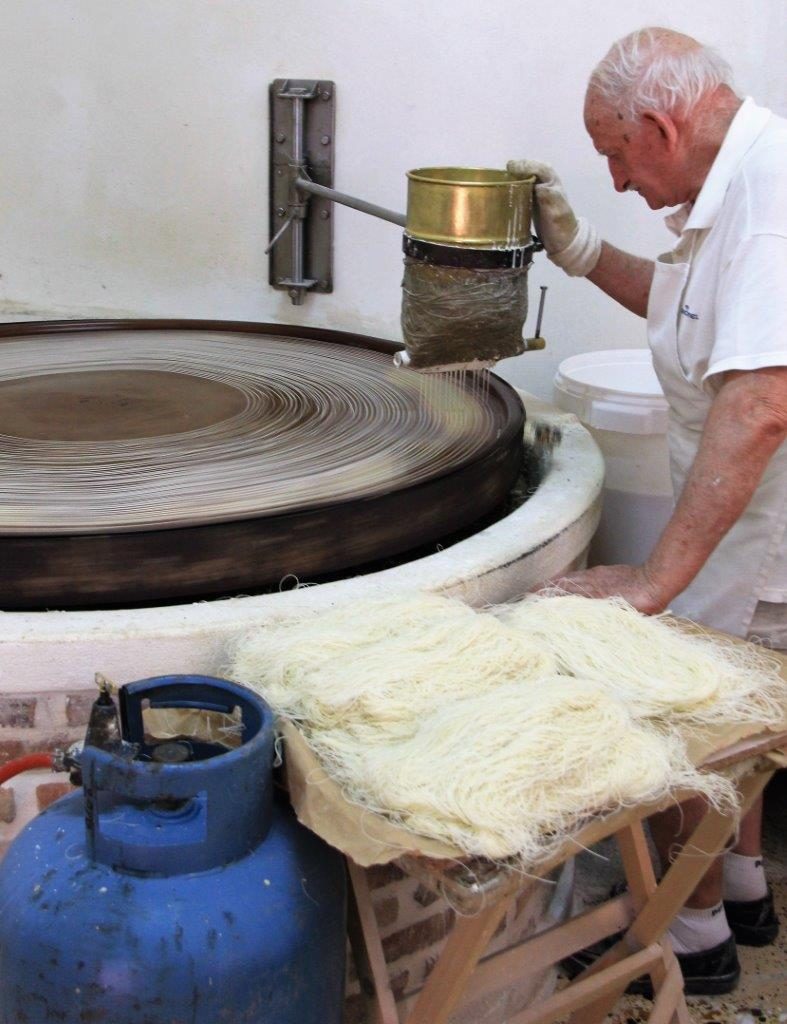
Handmade Phyllo Pastry and Kantaifi
Traditional foods in Crete also covers many sweeter options. While wandering around Rethymnon we stumbled across the most incredible little “factory”. Peering through the unassuming door into a somewhat dark room, I noticed an elderly man at a large machine. The door was open and there were other people inside, so of course we had to see what it was all about.
Kantaifi, a pastry spun on a large machine to make long thread-like pastry used in many Greek sweets, was being made. George Hatjparashos and his wife Katrina have been making kantaifi and phyllo pastry from hand in this factory for over 60 years! I don’t know which was more amazing watching him make the pastry or the fact he has been doing this for 60 years!
You can buy both pastry and sweets from the factory door. What an amazing find! Check it out on this very short video:
Loukoumades
And we end our list of traditional Cretan foods with dessert. Dessert varies from beautiful pastries made with phyllo or handspun pastry dough, to simple yogurt or cheese with honey, or just fresh fruit.
But one of my favorites is loukoumades. These are small donuts, served drizzled with honey. While found on menus throughout Greece, but they are originally from Crete. Loukoumades Greek donuts are surprisingly easy to make at home. Loukoumades was the complementary dessert served at Chrisostamos in Chania.
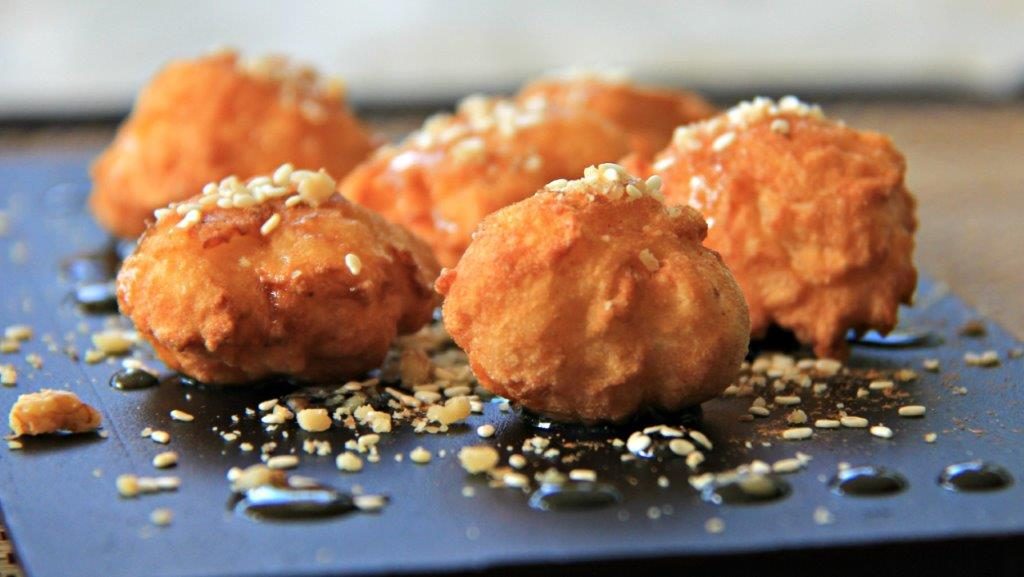
We hope you enjoyed learning more about the traditional food, wine and drinks of Crete. Many of these items are found throughout Crete and probably even in a Greek restaurant near you at home.
You can find out more information about restaurants and where to visit on you trip to Crete here.


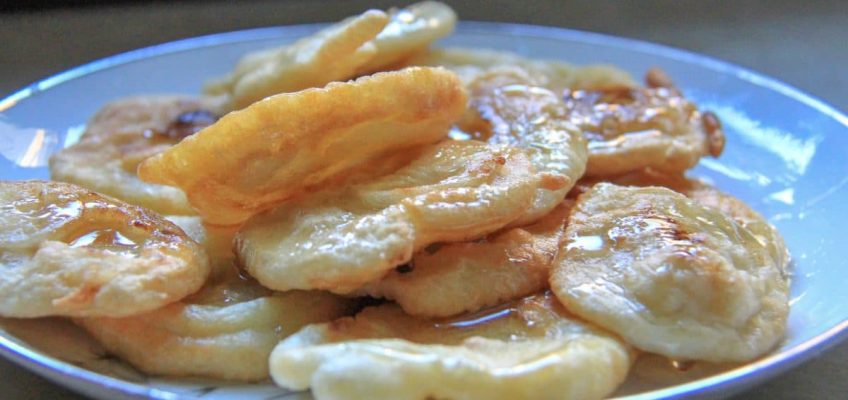

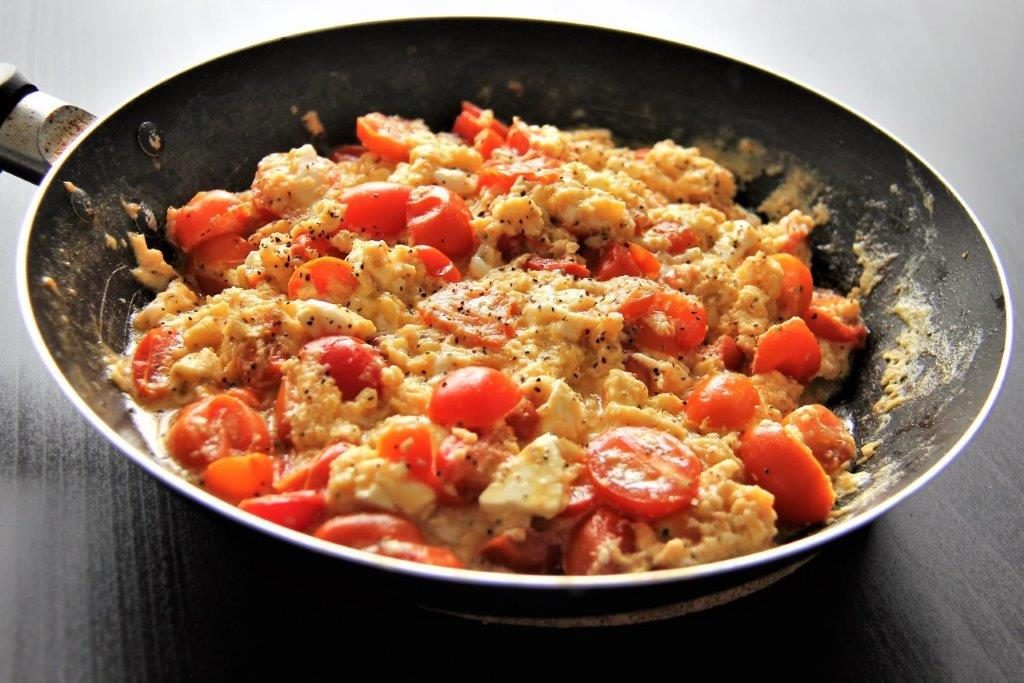
George Zikos
That’s an awesome picture of the kataifi being made! I’ve never seen that before. I lived in Crete for 6 months in a village with my aunt and uncle. They cooked a lot of the traditional foods that you have in this article. I actually wrote an article describing my experience if you’d like to read it!
Editor
Hi George. Thanks for your comment. We adored the food on Crete and the fact that it was so simple but so good. When the food is so good, you certainly don’t need to over-complicate the cooking process.